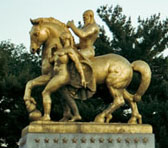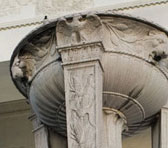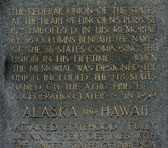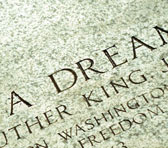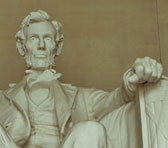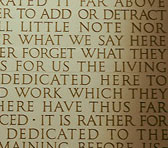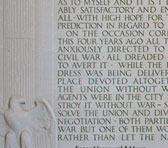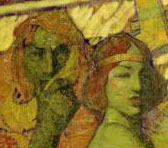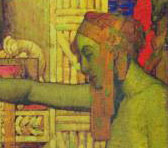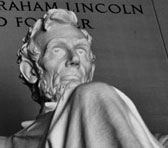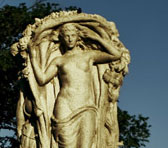Arlington Memorial Bridge
The Arlington Memorial Bridge symbolically and physically links the Lincoln Memorial with Arlington National Cemetery. General Robert E. Lee's house stands prominently atop the ridge. Leo Friedlander's two gilded-bronze equestrian statues, the “The Arts of War, ” grace the entrance to the bridge. Italy performed the casting as a gift to this nation in 1950.
Roman Fasces
This symbol dates to ancient Rome where it represented the power and authority of the state. The sticks represent power and the axe the right to exercise that power over the people. It symbolically states the people must serve their government.
Alaska and Hawaii Plaque
Symbolizing unity, the Lincoln Memorial lists all 36 states at the time of the Civil War on the lower frieze. All the states at the time of dedication in 1922 are listed on the upper frieze. The plaque listing Hawaii and Alaska was added so that all states would be represented.
Martin Luther King Inscription
From this spot, Martin Luther King advanced the cause of the civil rights movement when he delivered his "I Have a Dream" speech in August 1963. Heard by hundreds of thousands, this speech has become a famous and important speech in American history.
Lincoln Statue
Daniel Chester French designed this 19-foot tall statue of Abraham Lincoln. The statue depicts a contemplative Lincoln in the middle of the Civil War, wrestling with how to hold the Union together and advance the cause of human liberty and equality.
Gettysburg Address
Lincoln delivered this famous speech in 1863 at dedication ceremonies for the new Soldiers National Cemetery in Gettysburg, Pennsylvania. Although it took just over two minutes to read, this speech captured the essence of the noble goals of the war and of the nation. It is here engraved in its entirety.
Second Inaugural Address
Lincoln's second Inaugural Address, delivered March 4, 1865, encouraged the nation to put aside the bitterness of the war and reunite. Lincoln revealed his plans for a gentle reconstruction, "With malice toward none, with charity for all."
"Reunion"
In this 60 x 12 foot mural, entitled "Reunion," artist Jules Guerin depicts the Angel of Truth rejoining North and South. The angel's wings protect the arts of Painting, Philosophy, Music, Architecture, Chemistry, Literature, and Sculpture. The veiled figure of the Future stands behind.
"Emancipation"
Jules Guerin represents emancipation using allegorical images. At center, the Angel of Truth breaks the bonds of slavery. The seated figure to the left holds the sword of Justice and the scroll of Law. On the right sits Immortality attended by the standing figures of Faith, Hope, and Charity.
American Fasces
The American fasces represent strength from unity. Any individual stick, representing an individual state, could be broken. However, bound together, the states, working in unity, cannot be broken. The absence of the axe, traditionally a part of this ancient symbol, indicates the supremacy of the people over the government.
John Ericsson Memorial
During his lifetime, John Ericsson revolutionized several facets of technology. The Swedish-born engineer-inventor is best known for his work during the Civil War when he transformed naval warfare through his design of the iron-plated USS Monitor. The movements of Ericsson's pencil across his drafting board were as crucial to victory as the movements of Lincoln's armies across battlefields.

